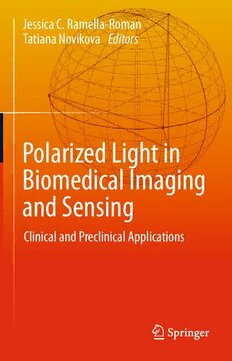
Polarized Light in Biomedical Imaging and Sensing: Clinical and Preclinical Applications PDF
Preview Polarized Light in Biomedical Imaging and Sensing: Clinical and Preclinical Applications
Jessica C. Ramella-Roman Tatiana Novikova Editors Polarized Light in Biomedical Imaging and Sensing Clinical and Preclinical Applications Polarized Light in Biomedical Imaging and Sensing Jessica C. Ramella-Roman • Tatiana Novikova Editors Polarized Light in Biomedical Imaging and Sensing Clinical and Preclinical Applications Editors JessicaC.Ramella-Roman TatianaNovikova DepartmentofBiomedicalEngineering LPICM,CNRS HerbertWertheimCollegeofMedicine, ÉcolePolytechnique,IPParis FloridaInternationalUniversity Palaiseau,France Miami,FL,USA ISBN978-3-031-04740-4 ISBN978-3-031-04741-1 (eBook) https://doi.org/10.1007/978-3-031-04741-1 ©SpringerNatureSwitzerlandAG2023 Thisworkissubjecttocopyright.AllrightsarereservedbythePublisher,whetherthewholeorpartof thematerialisconcerned,specificallytherightsoftranslation,reprinting,reuseofillustrations,recitation, broadcasting,reproductiononmicrofilmsorinanyotherphysicalway,andtransmissionorinformation storageandretrieval,electronicadaptation,computersoftware,orbysimilarordissimilarmethodology nowknownorhereafterdeveloped. Theuseofgeneraldescriptivenames,registerednames,trademarks,servicemarks,etc.inthispublication doesnotimply,evenintheabsenceofaspecificstatement,thatsuchnamesareexemptfromtherelevant protectivelawsandregulationsandthereforefreeforgeneraluse. Thepublisher,theauthors,andtheeditorsaresafetoassumethattheadviceandinformationinthisbook arebelievedtobetrueandaccurateatthedateofpublication.Neitherthepublishernortheauthorsor theeditorsgiveawarranty,expressedorimplied,withrespecttothematerialcontainedhereinorforany errorsoromissionsthatmayhavebeenmade.Thepublisherremainsneutralwithregardtojurisdictional claimsinpublishedmapsandinstitutionalaffiliations. ThisSpringerimprintispublishedbytheregisteredcompanySpringerNatureSwitzerlandAG Theregisteredcompanyaddressis:Gewerbestrasse11,6330Cham,Switzerland Contents PolarizedLight................................................................... 1 TatianaNovikovaandJessicaC.Ramella-Roman Mueller Matrix Analysis, Decompositions, and Novel QuantitativeApproachestoProcessingComplexPolarimetricData ...... 25 OriolArteagaandRazvigorOssikovski Mueller Matrix Polarimetry in Biomedicine: Enabling Technology,BiomedicalApplications,andFutureProspects ............... 61 MichaelD.Singh,NirmalyaGhosh,andI.AlexVitkin Polarization-SensitiveMonteCarlo............................................ 105 TatianaNovikovaandJessicaC.Ramella-Roman PolarizedLightImagingoftheSub-diffuseRegimeofTissues............. 133 StevenL.Jacques Mueller Polarimetric Imaging for Cervical Intraepithelial NeoplasiaDetection.............................................................. 149 AngeloPierangelo,TatianaNovikova,JeanRehbinder,AndréNazac, andJérémyVizet PolarimetricEndoscopy......................................................... 179 JiQiandDanielS.Elson MuellerPolarimetryofBrainTissues ......................................... 205 TatianaNovikova,AngeloPierangelo,PhilippeSchucht,IgorMeglinski, OmarRodríguez-Núñez,andHeeRyungLee ClinicalApplicationsofPolarization-SensitiveOpticalCoherence Tomography ...................................................................... 231 MartinVilligerandBrettE.Bouma v vi Contents Tractography Using Polarization-Sensitive Optical CoherenceTomography......................................................... 263 GangYao MuellerMatrixMicroscopy..................................................... 281 HuiMa,HonghuiHe,andJessicaC.Ramella-Roman ConfocalLaserScanningPolarimetry......................................... 321 MariacarlaGonzalez,V. N.DuLe,andJessicaC.Ramella-Roman Improvement of Resolution and Polarisation Measurement PrecisioninBiomedicalImagingThroughAdaptiveOptics ................ 345 ChaoHeandMartinJ.Booth Index............................................................................... 361 Polarized Light TatianaNovikovaandJessicaC.Ramella-Roman 1 Introduction Humanvisionisnotsensitivetothepolarizationofthelight.Wedetecttheintensity of the visible light and its wavelengths (as a color), but the vector nature of the light—polarization—escapeshumaneyes,contrarytosomeanimalsandinsects[1]. When polarized probing light interacts with a sample, the polarization of reflected,transmitted,andscatteredlightwillchange,andanysample’spolarimetric properties can be investigated through specialized instrumentation. The polarized lightmicroscope,introducedintheearly1800[2],isanexampleofpolarizedlight applicationtowardtheinvestigationofmaterialproperties. Recently, new focus has been given to polarized light imaging and sensing for biomedical applications, with studies that go beyond microscopy and include measurements in bulk tissue; this is the focus of our book. Although early work introduced the use of polarized light in imaging of cells, bacteria, and other small biologicalparticles,[3–5]Andersonin1991[6]wasthefirsttofocusonbulktissue reporting on the use of polarized sunglasses and cross-polarization imaging for dermatological applications, particularly for enhancement of vascular contrast in thestudyofrosaceaandtominimizesurfaceglare.Jacquesetal.[7]continuedthis effortdevelopingaclinic-readytoolandfocusingonskincancerimagingenhancing T.Novikova LPICM,CNRS,ÉcolePolytechnique,IPParis,Palaiseau,France FloridaInternationalUniversity,BiomedicalEngineeringDepartment,Miami,USA J.C.Ramella-Roman((cid:2)) FloridaInternationalUniversity,BiomedicalEngineeringDepartment,Miami,FL,USA FloridaInternationalUniversity,HerbertWertheimCollegeofMedicineCellularBiologyand Pharmacology,DepartmentofOphthalmology,Miami,FL,USA e-mail:Jramella@fiu.edu ©SpringerNatureSwitzerlandAG2023 1 J.C.Ramella-Roman,T.Novikova(eds.),PolarizedLightinBiomedicalImaging andSensing,https://doi.org/10.1007/978-3-031-04741-1_1 2 T.NovikovaandJ.C.Ramella-Roman thebordersofthelesionthatwerenotvisibletothenakedeye,sodidMorganetal. [8,9]investigatingcircularpolarizationratherthanlinearstates. Demos et al. [10, 11] investigated the spectral dependence of polarized light penetration in biological media; spectral polarization difference imaging was utilized todemonstrate subsurface imaging atdifferent depths. Intravital polarized microscopyformeasurementofperfusionwasstudiedbyGroneretal.[12–17]. The expansion of research in the use of polarized light for biomedical applica- tionsinthelast30yearshasbeentremendousandhasbeenpropelledbyadvances inbothinstrumentationandmethodologies.Severalarticleshaverecentlyreviewed the state of the field [18–22]. Here we hope to expand on this work by covering in-depthsomeofthemostinterestingapplicationsofpolarizedlights. In this chapter, we briefly review the theoretical descriptions of the light polarizationproperties,namely,theJonesformalismfortotallypolarizedlightand theStokes–Mueller formalism,which ismoregeneral and canadequately account foranypolarizationstate. 1.1 JonesFormalism Theelectromagneticfieldpropagatingasawaveindifferentmediaisaspatiotempo- ralfieldwhichisvectorialbyitsnature,couplingthevectorofelectricfieldstrength E(r, t) and the vector of magnetic field strength H(r, t). r is the vector of spatial position,andtisthetime.Sometimesonecanignorethevectornatureofthelight and treat it within the frame of scalar theory, like it is done in the geometrical ray opticstheory. Nevertheless, the study of polarization of light requires the full vector descrip- tion.Ifthetemporalevolutionofavectorofelectromagneticfieldatthegivenpoint of a space is identical for all the space points, we call this electromagnetic field polarized.Otherwise,wedealwithapartiallyorevencompletelydepolarizedstate ofanelectromagneticfield. The light propagation in time and space can be fully described by Maxwell’s equations[23]: ∂B(r,t) ∇·D(r,t)=ρ, ∇×E(r,t)=− (1) ∂t ∂D(r,t) ∇·B(r,t)=0, ∇×H(r,t)=J+ (2) ∂t D=εE, B=μH, J=σ E (3) PolarizedLight 3 wheret-time,D-dielectricdisplacementvector,ρ-chargedensity,E-vectorofelec- tric field strength, B-magnetic induction or magnetic flux density vector, H-vector of magnetic field strength, J-current density, ε-dielectric constant (or dielectric permittivity) of the medium, μ-magnetic permeability of the medium (in the most generalcase,εandμarethetensors),σ-electricalconductivityofthemedium. The values of ε and μ are constant in a homogeneous medium. Moreover, for a homogeneous linear optical material without any charge and current densities, ρ =0;J=0;σ =0.Equations(1),(2),and(3)canbewrittenas ∂B(r,t) ∇·D(r,t)=0, ∇×E(r,t)=− (4) ∂t ∂D(r,t) ∇·B(r,t)=0, ∇×H(r,t)= (5) ∂t D=εE, B=μH (6) Maxwell’s equations can be further simplified and formulated for electric and magneticfieldsseparatelybytakingthecurl(∇×)of(4)and(5).Theelectricand magneticfieldsthenobeythewell-knownwaveequations: ∂2E(r,t) ∇2E(r,t)−με =0 (7) ∂t2 ∂2H(r,t) ∇2H(r,t)−με =0 (8) ∂t2 Solving the problem for a propagation of the electric wave E, one can further findthesolutionforthemagneticwaveH,andfinallyobtainthecompletesolution ofMaxwell’sequations. Itwasshownthatanyelectromagneticfieldmaybedecomposedintoaninfinite number of monochromatic waves with angular frequency ω, any of which in turn i canbedecomposedintoaninfinitenumberofplanewaveswiththewavevectork j [24].Fourierintegraltheorydescribesthisbythefollowingequation: (cid:2) (cid:2) D(r,t)= dω D(k,ω)exp[j(ωt −kr)] dk (9) ω k Hence, for the studies of light polarization properties, we can consider an elementarycomponentofthisdecomposition,namely,aplanemonochromaticwave characterized by itsangular frequency ω and wavevector k. Iftheelectromagnetic fieldsassociatedwiththeelementarycomponentshavethesamevectorialbehavior, theproblemcanbeeasilysolved. 4 T.NovikovaandJ.C.Ramella-Roman When a plane homogeneous optical wave travels through an infinite isotropic medium,theelectricfieldEisconfinedtooscillateintheplaneofthewave,which isorthogonaltothewavevectork.Withoutthelossofgenerality,wecandefinethe Ozaxisasthedirectionofwavepropagation(k=kz,z-unitvectorsalongOzaxis). TheoscillationofelectricfieldEintheplaneorthogonaltoOzaxisandintersecting Oz axis at point (0, 0, z) is the superposition of two independent simple harmonic oscillationsE ’andE ’[25]. x y (cid:3) (cid:6) (cid:3) (cid:6) E(z,t)= EE˜˜xccooss(cid:4)(ωωtt −−kkzz++δδx)(cid:5) = EEx(cid:3)(cid:3) (10) y y y ˜ where E and δ are the amplitude and the phase of the oscillation along the i- i i axis, respectively, ω–angular frequency of temporal harmonic oscillations of the components of monochromatic field. Using a complex number representation, a monochromatic wave propagating through an infinite isotropic medium can be writteninaform: E(z,t)=Re{E(z)exp(jωt)} (11) where (cid:3) (cid:6) ˜ E(z)=exp(−jkz) E˜xexp(cid:4)(jδx)(cid:5) (12) E exp jδ y y Toexcludethespatialdependenceonz,wedefinethevectorE(0)as (cid:3) (cid:6) (cid:3) (cid:6) ˜ E(0)= E˜xexp(cid:4)(jδx)(cid:5) = Ex (13) E exp jδ E y y y It follows from (11), (12), and (13) that if we know the oscillations of electric field at time t = 0 and plane z = 0, we can reconstruct the electromagnetic field at any time and any point of the space just by multiplying E(0) by the factor exp(−j(kz−ωt))andtakingtherealpartoftheresultingexpression. E(z,t)=Re{E(0)exp(−j(kz−ωt))} (14) The vector E(0) (see Eq. 13) is called the Jones vector. It provides a compact descriptionofahomogeneousmonochromaticharmonicwave.Itisworthmention- ingthattheelementsE andE ofJonesvectorarecomplexnumbers;hence,Jones x y vectorisnotavectorinarealspace.
